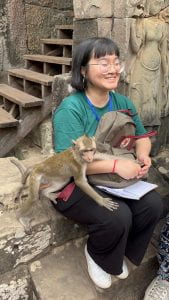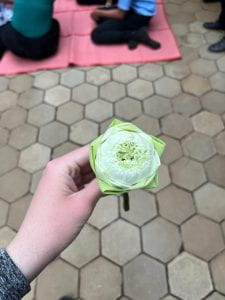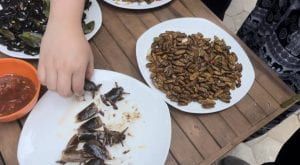 Today, we explored the magnificent ruins of the Bayon temple, which was built in the 12th century during the rule of king Jayavarman VII. The structure features multiple mysterious, four-faced towers. Scholars still debate the meaning of the faces – some think they represent the Hindu god Brahma, while others believe they symbolically protect the empire by scanning for threats in all directions.
Today, we explored the magnificent ruins of the Bayon temple, which was built in the 12th century during the rule of king Jayavarman VII. The structure features multiple mysterious, four-faced towers. Scholars still debate the meaning of the faces – some think they represent the Hindu god Brahma, while others believe they symbolically protect the empire by scanning for threats in all directions.

 While exploring the outer galleries, we discovered a series of reliefs depicting a battle between the Khmer empire and the Cham (whose descendants live in modern-day Viet Nam). Interestingly, the relief shows the Cham defeating the Khmer – a strange scene for a Khmer king to allow on his temple. But, as our guide explained, Buddhism emphasizes honesty, and perhaps the temple itself showed that the Khmer had recovered and risen to new power.
While exploring the outer galleries, we discovered a series of reliefs depicting a battle between the Khmer empire and the Cham (whose descendants live in modern-day Viet Nam). Interestingly, the relief shows the Cham defeating the Khmer – a strange scene for a Khmer king to allow on his temple. But, as our guide explained, Buddhism emphasizes honesty, and perhaps the temple itself showed that the Khmer had recovered and risen to new power.
Buddhism and Hinduism “encompass” one another, and followers of each can view the other as a chapter in the story of the world. As a result, Buddhists and Hindus did not necessarily seek to eradicate each other’s beliefs or material legacy. However, when the Khmer empire converted from Buddhism to Hinduism, the Hindus destroyed images of the Buddha (as seen here), much like Christians destroyed pagan icons in Europe. When the empire later converted back to Buddhism though, most Hindu icons remained (although some statues were moved to less prominent locations).
However, when the Khmer empire converted from Buddhism to Hinduism, the Hindus destroyed images of the Buddha (as seen here), much like Christians destroyed pagan icons in Europe. When the empire later converted back to Buddhism though, most Hindu icons remained (although some statues were moved to less prominent locations).
 A group of three long-tailed macaques assaulted us on the steps of the temple and tried to steal our food and valuables. They leapt onto us and rifled through our bags until we’d finally had enough and officially declared war. We tried distracting the monkeys with a banana, but to no avail. Finally, Magnus managed to scare them off, but something tells me we haven’t seen the last of them…
A group of three long-tailed macaques assaulted us on the steps of the temple and tried to steal our food and valuables. They leapt onto us and rifled through our bags until we’d finally had enough and officially declared war. We tried distracting the monkeys with a banana, but to no avail. Finally, Magnus managed to scare them off, but something tells me we haven’t seen the last of them…
After lunch, we enjoyed a wonderful lecture at the Center for Khmer Studies on Cambodian classical dance, a tradition extending as far back as the Khmer Empire itself. We learned the history of the dance and interviewed a group of dancers about the impact COVID 19 had on their art.
 Later, we visited SPOONS Cafe, an organization founded by a Cornell alumnus, that helps prepare Cambodians from low income backgrounds to work in the hospitality industry. We toured the classrooms, gardens, and offices, before getting the chance to meet students. They showed us how to fold lotuses, make napkin hats, and prepare fresh spring rolls. We even had a chance to try some authentic Cambodian cuisine — beetles, silkworms, and water bugs!
Later, we visited SPOONS Cafe, an organization founded by a Cornell alumnus, that helps prepare Cambodians from low income backgrounds to work in the hospitality industry. We toured the classrooms, gardens, and offices, before getting the chance to meet students. They showed us how to fold lotuses, make napkin hats, and prepare fresh spring rolls. We even had a chance to try some authentic Cambodian cuisine — beetles, silkworms, and water bugs!